Oh! The hum of the motor and agitator sloshing water around. Some light knocking of course as the pawl or tub break keeps the tub stationary. The rest should be silent. No need to the suspension to be part of the wash action.
You are using an out of date browser. It may not display this or other websites correctly.
You should upgrade or use an alternative browser.
You should upgrade or use an alternative browser.
Why do all newer transmission made Speed Queens low speed spin drain after main wash?
- Thread starter user 2984
- Start date
agree
I agree fully. As for the pump running during wash, I'd like to hear that sound as air rushes through, or better yet when both air and water rush through.
I agree fully. As for the pump running during wash, I'd like to hear that sound as air rushes through, or better yet when both air and water rush through.
Running the pump during wash theoretically pushes detergent back into the tub. Vintage machines were perfect in the way they were designed.
biggpete
Active member
Slow Spin Speeds
Out of total due respect to all the comments here, I do appreciate the passion that people are having towards the SQ’s lower spin speed from main to first. I think it would help to lower the temp a little bit. Lol! As I previously mentioned, I do own the TC-5003. I am not loyal to any brand due to things possibly changing on a dime in any corporate which may mean not for the best. I do very much appreciate very well built products preferably made in the USA first and foremost.
After my TC-5003 arrived, the first thing I noticed was the slower main to first spin speed. I am a perfectionist. After many loads done and critically observing the rinse water. It was very apparent to me that the speed of the first spin was definitely sufficient in providing a clean rinse.
Let’s also keep in mind that the SQ TC-5003 has a top spin speed of 710. That’s a top speed of the final spin. A lot of washers, not all, in that class of top loaders, as in old school agitators, filling all the way up w/ water and traditional agitation and functionality have a top spin speed in the final spin of somewhere around 500-550 such as but not limited to WP DD.
Age wise, I’m a half a century. I have used all sorts of top loaders ranging from washers made in the 50’s to recent. All of them have had a shorter in time and somewhat slower main to first spin. So let’s keep in mind that if you’re observing the final spin of the current or recent SQ top loader which is faster then most but not all and comparing it to the first spin it may seem like it’s a lot slower than before however it’s most likely relatively similar to what it’s always been. In other words, SQ top loaders have faster final spins than most which may give the appearance that they drastically changed the first spin to a slower speed. I will say it does seem like it’s been slowed “some” but definitely not a lot to write home to Mom and Dad about.
Keep in mind to, the drain pipe suds overflow is a real and can be an expensive issue it damage to flooring or whatever occurs. Also keep in mind what ‘Combo 52’ said. He said it happens in, “Some duelings,” that he’s serviced. So, I’m very glad that some people on here have never had to deal or experience that. However, for others it’s been a big issue.
I’m very appreciative that SQ fixed the standpipe over sudsing issue with what seems to be a slightly slower first spin speed. I haven’t noticed any difference in any kind of quality of wash or rinse. The damn thing does an awesome bang up job through and through!! The rinse is perfect! My parents who use this washer on a semi daily basis have zero complaints. It is hooked up to a stand pipe and there is no overflow of suds or whatever. I got this washer for them so I don’t have to hear their whinny voices complain about a cheep, decrepit washer they choose to buy that’s not working or cleaning! All issues stopped for me and them the day the SQ TC-5003 arrived! No joke!
Out of total due respect to all the comments here, I do appreciate the passion that people are having towards the SQ’s lower spin speed from main to first. I think it would help to lower the temp a little bit. Lol! As I previously mentioned, I do own the TC-5003. I am not loyal to any brand due to things possibly changing on a dime in any corporate which may mean not for the best. I do very much appreciate very well built products preferably made in the USA first and foremost.
After my TC-5003 arrived, the first thing I noticed was the slower main to first spin speed. I am a perfectionist. After many loads done and critically observing the rinse water. It was very apparent to me that the speed of the first spin was definitely sufficient in providing a clean rinse.
Let’s also keep in mind that the SQ TC-5003 has a top spin speed of 710. That’s a top speed of the final spin. A lot of washers, not all, in that class of top loaders, as in old school agitators, filling all the way up w/ water and traditional agitation and functionality have a top spin speed in the final spin of somewhere around 500-550 such as but not limited to WP DD.
Age wise, I’m a half a century. I have used all sorts of top loaders ranging from washers made in the 50’s to recent. All of them have had a shorter in time and somewhat slower main to first spin. So let’s keep in mind that if you’re observing the final spin of the current or recent SQ top loader which is faster then most but not all and comparing it to the first spin it may seem like it’s a lot slower than before however it’s most likely relatively similar to what it’s always been. In other words, SQ top loaders have faster final spins than most which may give the appearance that they drastically changed the first spin to a slower speed. I will say it does seem like it’s been slowed “some” but definitely not a lot to write home to Mom and Dad about.
Keep in mind to, the drain pipe suds overflow is a real and can be an expensive issue it damage to flooring or whatever occurs. Also keep in mind what ‘Combo 52’ said. He said it happens in, “Some duelings,” that he’s serviced. So, I’m very glad that some people on here have never had to deal or experience that. However, for others it’s been a big issue.
I’m very appreciative that SQ fixed the standpipe over sudsing issue with what seems to be a slightly slower first spin speed. I haven’t noticed any difference in any kind of quality of wash or rinse. The damn thing does an awesome bang up job through and through!! The rinse is perfect! My parents who use this washer on a semi daily basis have zero complaints. It is hooked up to a stand pipe and there is no overflow of suds or whatever. I got this washer for them so I don’t have to hear their whinny voices complain about a cheep, decrepit washer they choose to buy that’s not working or cleaning! All issues stopped for me and them the day the SQ TC-5003 arrived! No joke!
2015 and newer models
The 2015 and newer models do this all the time even on heavy duty cycle. That was a stupid decision. The early spray rinse is stupid too. What the heck? The normal cycle is for heavy duty fabrics if heavy duty cycles aren't available. The heavy soil option will suffice on commercial models.[this post was last edited: 6/24/2024-15:38]
The 2015 and newer models do this all the time even on heavy duty cycle. That was a stupid decision. The early spray rinse is stupid too. What the heck? The normal cycle is for heavy duty fabrics if heavy duty cycles aren't available. The heavy soil option will suffice on commercial models.[this post was last edited: 6/24/2024-15:38]
The early spray rinse Jerome is very helpful. It makes zero sense to have it at the end of the cycle like the direct drives had. It’s to rinse away as much detergent and nastiness leftover from the main wash cycle so that when it refills with water for the rinse, it has less to rinse out.
kalanikaau1
Well-known member
spray rinse
According to the timer chart on my 2018 LWN432SP115TW01, when the reg/perm-press cycle is selected, the spin and spray event happens about 2/3rd. of the total time of the initial main wash spin event.
This spin event, according to the chart lasts just 6 minutes and the motor is run at slow speed, I'm sure SQ had their reasons for spinning the tub at a reduced speed.
However, if the extra rinse option is selected, the tub is spun at a higher speed to extract the rinse water.
With this setup it seems as though the extra rinse option must be selected for maximum rinse water extraction...strange
According to the timer chart on my 2018 LWN432SP115TW01, when the reg/perm-press cycle is selected, the spin and spray event happens about 2/3rd. of the total time of the initial main wash spin event.
This spin event, according to the chart lasts just 6 minutes and the motor is run at slow speed, I'm sure SQ had their reasons for spinning the tub at a reduced speed.
However, if the extra rinse option is selected, the tub is spun at a higher speed to extract the rinse water.
With this setup it seems as though the extra rinse option must be selected for maximum rinse water extraction...strange
Its not that the spray rinse is in the first rinse, is that at low speed it starts with the tub 1/3 full of water and at high speed 1/10th full. To early. Let the tub coast up to speed then spray.
I agree with that. The heavier and bigger the load the longer it takes for it to reach maximum speed. Lighter and smaller loads usually reach full speed just before the spray rinse occurs in my experience with some brand new and slightly older commercial series, non coin operated.
What the heck?
What the heck were they thinking with that idea anyway?
What the heck were they thinking with that idea anyway?
early spray rinses
When I mean early spray rinse, I mean when the tub hasn't been completely empty yet. What the heck? My clothes do get clean nonetheless, but still!
When I mean early spray rinse, I mean when the tub hasn't been completely empty yet. What the heck? My clothes do get clean nonetheless, but still!
This is a ridiculous discussion
Of all the tens of thousands of Speed Queen top load washers we’ve worked on no customer has ever complained that it has a low speed first spin or have has any customer ever complained about the spray rinse pattern of any top load washer I’ve ever worked on of any brand.
There are many different ways to do things, and I know it’s interesting but it’s not a real problem that’s worth very much of your time and worry.
John
Of all the tens of thousands of Speed Queen top load washers we’ve worked on no customer has ever complained that it has a low speed first spin or have has any customer ever complained about the spray rinse pattern of any top load washer I’ve ever worked on of any brand.
There are many different ways to do things, and I know it’s interesting but it’s not a real problem that’s worth very much of your time and worry.
John
Only because people have no clue what goes in an any particular home appliance. To them it is simply magic. People are willing to accept a substantial degree if imperfection if they are unaware of anything better or know the root cause. Ignorance is bliss.
There are indeed a number of ways to do things, and some produce good results, other not so good results.
If everyone were like me home laundry appliances would be one of humanities magnum opuses. A profound example of the epitome of elegance, beauty, utility and engineering perfection.
Personally I'd like to know why Speed Queen at the last minute decided to change the original design concept which started the spray rinse in the second timer increment of the first spin to the first increment.
There are indeed a number of ways to do things, and some produce good results, other not so good results.
If everyone were like me home laundry appliances would be one of humanities magnum opuses. A profound example of the epitome of elegance, beauty, utility and engineering perfection.
Personally I'd like to know why Speed Queen at the last minute decided to change the original design concept which started the spray rinse in the second timer increment of the first spin to the first increment.
I agree that the volume of the discussion is a little ridiculous but that’s what this forum is for after all, appliance talk. I just wanted insight to see why in the world they suddenly changed the first spin to a low speed after decades of using high speed spins, and I wasn’t the only one who has that question. I totally agree Chetleham. Never thought this thread would of got the amount of replies it did but this is what keeps us all talking and most importantly, learning. No matter how much experience one has there’s always room to learn.
"Of all the tens of thousands of Speed Queen top load washers we’ve worked on no customer has ever complained that it has a low speed first spin or have has any customer ever complained about the spray rinse pattern of any top load washer I’ve ever worked on of any brand."
How many of those customers bypassed the lid and watched the entire cycle? Probably none. How many have the experience to recognize what a good spray or deep rinse actually is? Probably little to none unless they have detergent allergies.
The spray pattern on the 2018+ SQ's that spin/spray on low aims at the bottom of the tub which is bullshit, useless, and a waste of water. They should have changed the fill flume to a fan spray...like some other manufacture did 68 years ago.
How many of those customers bypassed the lid and watched the entire cycle? Probably none. How many have the experience to recognize what a good spray or deep rinse actually is? Probably little to none unless they have detergent allergies.
The spray pattern on the 2018+ SQ's that spin/spray on low aims at the bottom of the tub which is bullshit, useless, and a waste of water. They should have changed the fill flume to a fan spray...like some other manufacture did 68 years ago.
So all those folks who haven't bypassed their machines' lid switches and aren't having any issues or complaints, there's no problems happening and all presumably is good in their laundry realms ...
to maytaga806
What the heck were they thinking? I've never opened the lid to check, but I stood there and listened to the machine doing a normal cycle.
When the machine went into the first spin, I thought, What the heck?.
What the heck were they thinking? I've never opened the lid to check, but I stood there and listened to the machine doing a normal cycle.
When the machine went into the first spin, I thought, What the heck?.
The original design had the spray rinse listed to trigger in the second increment and the tech sheets reflected that. For some reason, not even published, Speed Queen changed it to the first increment.
(and if everyone is wondering why I deleted my reply its because I wanted to bite my tongue and not get into an argument over John's pointless, disparaging remarks which add nothing of value. But seeing his post received 4 upvotes {check marks} has me questioning if I'm on the right forum to begin with. Its not ridiculous when the water entering the tub is already full of water but what do I perceive maybe I'm just imagining all of it)
(and if everyone is wondering why I deleted my reply its because I wanted to bite my tongue and not get into an argument over John's pointless, disparaging remarks which add nothing of value. But seeing his post received 4 upvotes {check marks} has me questioning if I'm on the right forum to begin with. Its not ridiculous when the water entering the tub is already full of water but what do I perceive maybe I'm just imagining all of it)
Low speed, initial spin
Speed Queen chose to do this to reduce wrinkling since there’s no dedicated permanent press cycle anymore, it also reduces foaming back up out of stand pipes, which was a real problem for Speed Queen because they use a cheap motor driven pump instead of using electric pump and do the draining first like they do on the same unit sold in many other countries.
Spraying water in while there’s still water in the tub acts again as a suds suppressor and cools the fabric slightly, which again helps the extraction process leading into the deep rinse.
No system is perfect. All decisions are a compromise in life. Speed Queen is doing the best they can. If you don’t like it don’t buy it if you’re really serious about laundry, you’d buy a front loading washer anyway.
John
Speed Queen chose to do this to reduce wrinkling since there’s no dedicated permanent press cycle anymore, it also reduces foaming back up out of stand pipes, which was a real problem for Speed Queen because they use a cheap motor driven pump instead of using electric pump and do the draining first like they do on the same unit sold in many other countries.
Spraying water in while there’s still water in the tub acts again as a suds suppressor and cools the fabric slightly, which again helps the extraction process leading into the deep rinse.
No system is perfect. All decisions are a compromise in life. Speed Queen is doing the best they can. If you don’t like it don’t buy it if you’re really serious about laundry, you’d buy a front loading washer anyway.
John
The premature spray began at least in the 2009 AWN timer models all of which had a dedicated PP cycle. In some machines it was more pronounced than others since AWN311, AWN412, AWN432 and AWN42 all varying timer increments per second. (I'll post pics)
Spraying 1.25 gallons of water on top of 10 gallons isn't going to do much cooling. Or knock down many suds.
The front load washer you advocate for have no heater making them pointless half the time.
There is compromise, and then there is being just flat out wrong.
Spraying 1.25 gallons of water on top of 10 gallons isn't going to do much cooling. Or knock down many suds.
The front load washer you advocate for have no heater making them pointless half the time.
There is compromise, and then there is being just flat out wrong.
Timer Increments and Sprays
Here are the original cycle diagrams from a 1998 Amana service manual depicting the same Amanas that would become the AWN series in latter years. Except for the addition of the motor start capacitor and the AWN542 being changed out from a 3 speed to a 2 speed motor the cycles, timers, and wiring are all identical.
"B" is the closing of the spray rinse contact. Note position in the cycle schematic.
Future AWN311, 1 minute 30 second timer increments:
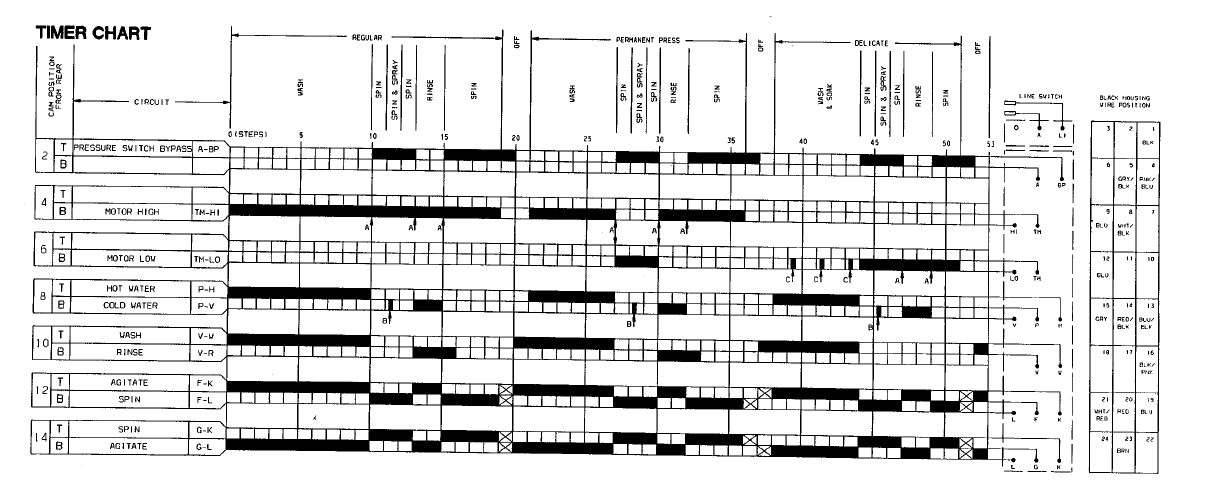
Future AWN412, 2 minute timer increments:
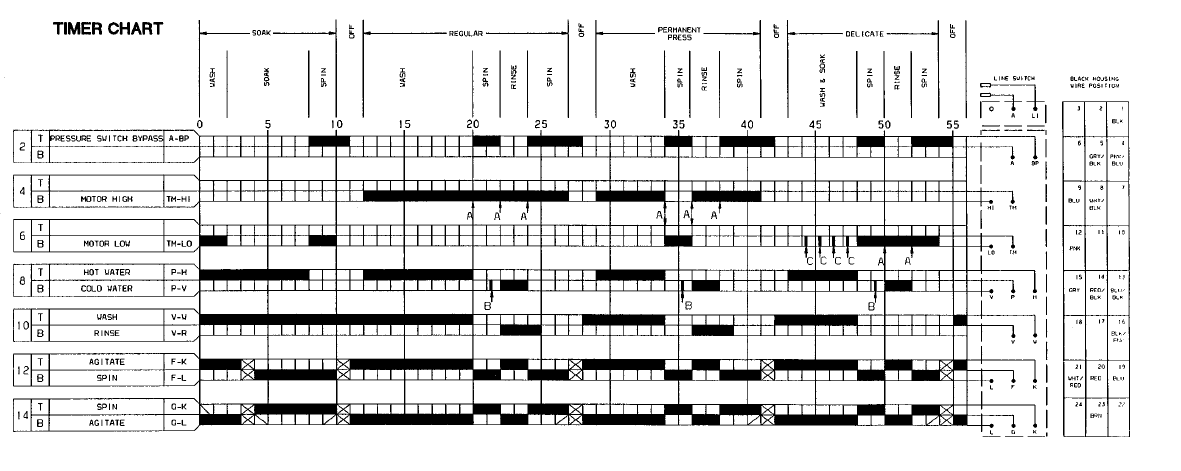
Future AWN432, 3 minute timer increments:
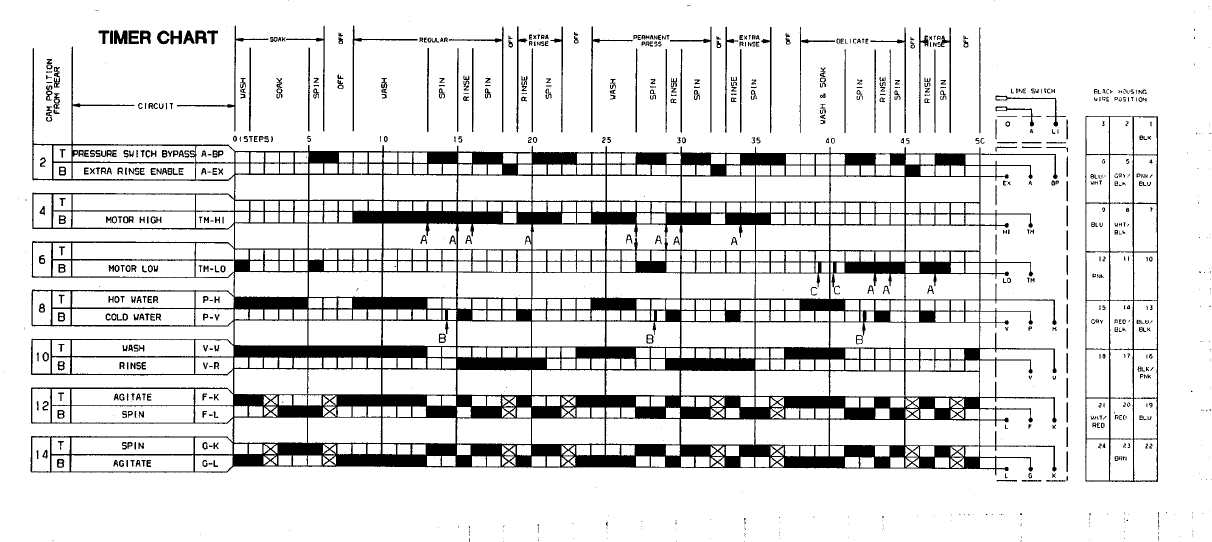
Future AWN542, 3 minute timer increments:
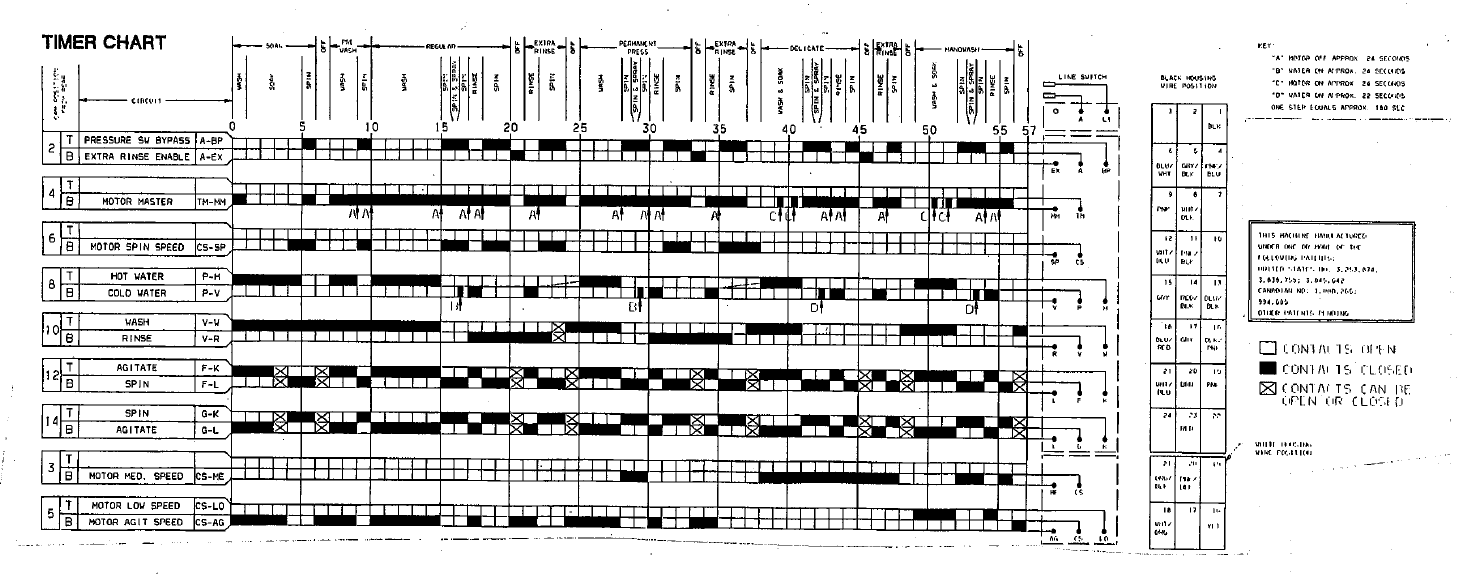
If we take a look at the listed cycle timing in the service manual the intent is the same- as to start the spray <span style="text-decoration: underline;">AFTER</span> the first spin increment is complete.
Future AWN 412:
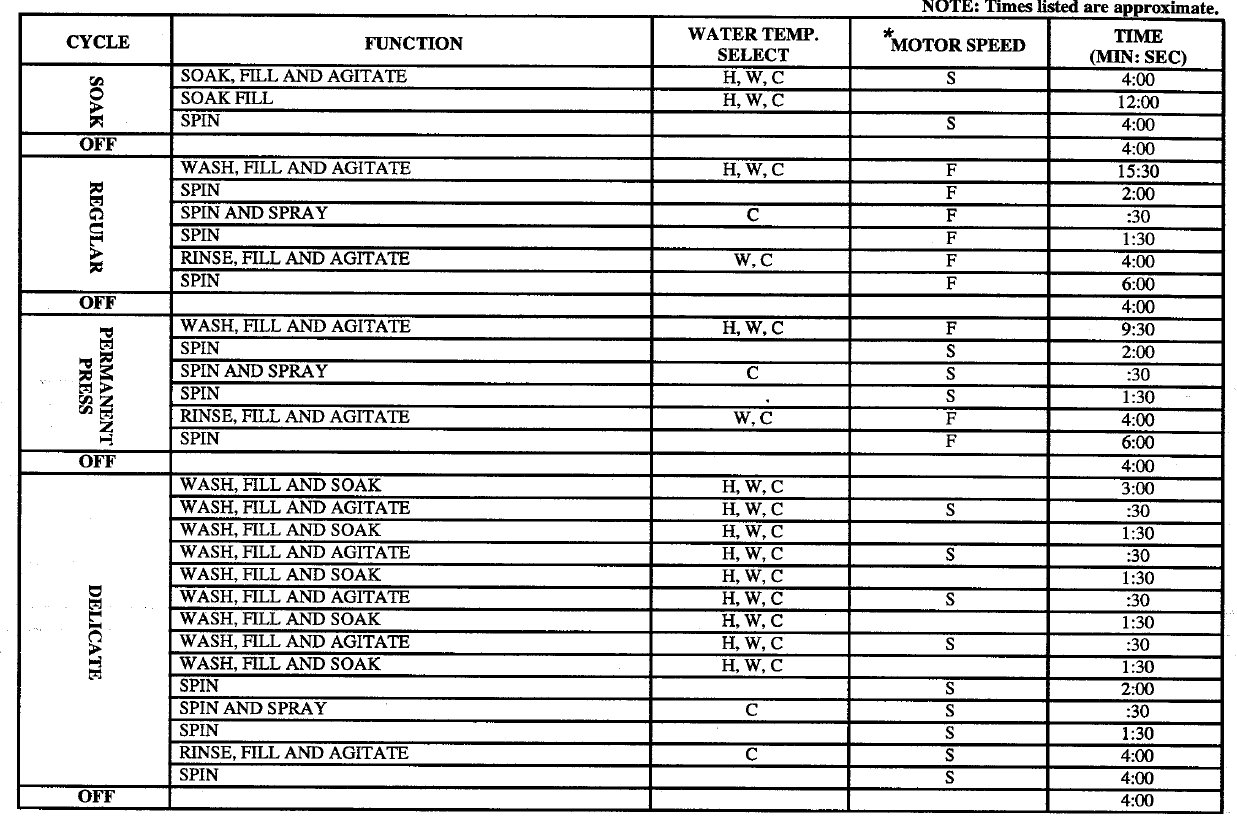
Future AWN542:
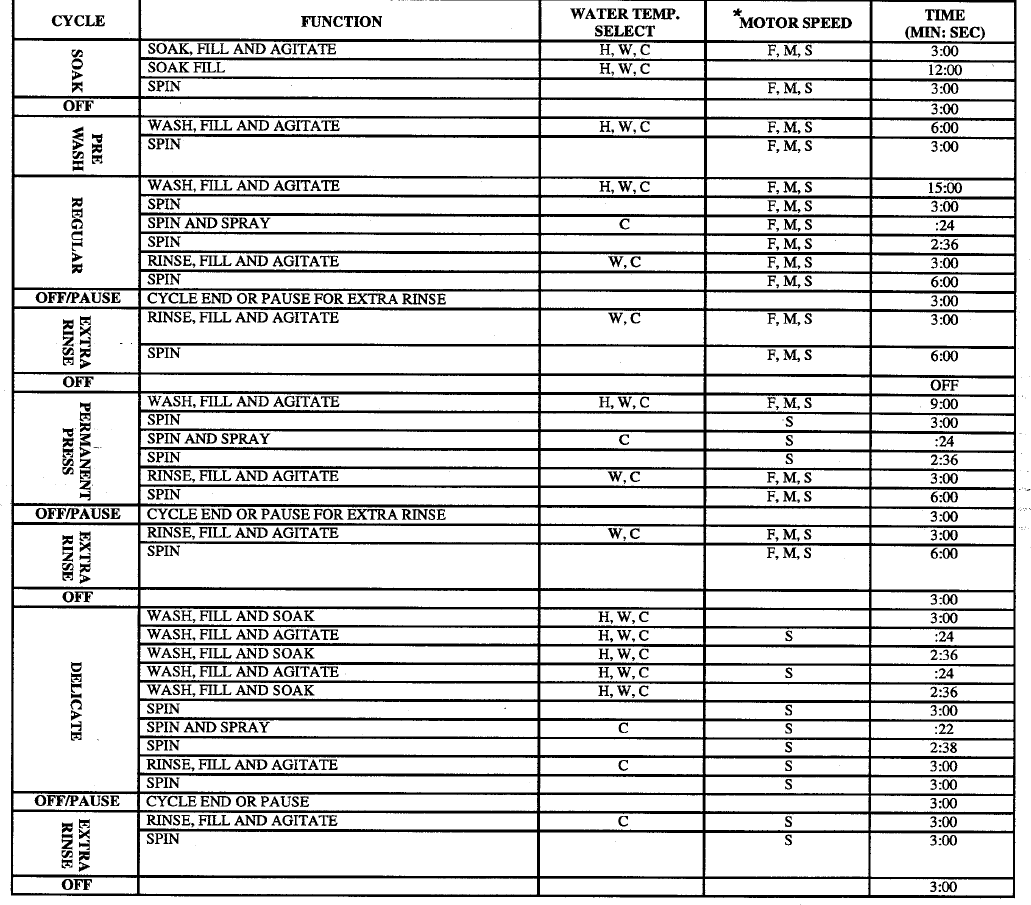
Amanas original intent was spelled out clearly, have the spray rinse begin more than 2 to 3 minutes after the tub started draining by then where all the water would have left the machine.
Alliance Speed Queen decided to shift the spray to the first timer increment covertly behind company doors, and have it start about 1 minute into the first increment which was NEVER the original intent of Amana or Raytheon. This timer engineering was completely unnecessary and counter productive. If everyone was like me, Alliance would be sending customers new timers with the spray starting where intended.
The PP argument is bogus, because while starting the spray at 1 minute works half way on high speed, at low speed the tub is still half full of water. Nothing is accomplished.
This was a workplace mistake, and I am angry LOL.
[this post was last edited: 7/21/2024-13:45]
Here are the original cycle diagrams from a 1998 Amana service manual depicting the same Amanas that would become the AWN series in latter years. Except for the addition of the motor start capacitor and the AWN542 being changed out from a 3 speed to a 2 speed motor the cycles, timers, and wiring are all identical.
"B" is the closing of the spray rinse contact. Note position in the cycle schematic.
Future AWN311, 1 minute 30 second timer increments:

Future AWN412, 2 minute timer increments:

Future AWN432, 3 minute timer increments:

Future AWN542, 3 minute timer increments:

If we take a look at the listed cycle timing in the service manual the intent is the same- as to start the spray <span style="text-decoration: underline;">AFTER</span> the first spin increment is complete.
Future AWN 412:

Future AWN542:

Amanas original intent was spelled out clearly, have the spray rinse begin more than 2 to 3 minutes after the tub started draining by then where all the water would have left the machine.
Alliance Speed Queen decided to shift the spray to the first timer increment covertly behind company doors, and have it start about 1 minute into the first increment which was NEVER the original intent of Amana or Raytheon. This timer engineering was completely unnecessary and counter productive. If everyone was like me, Alliance would be sending customers new timers with the spray starting where intended.
The PP argument is bogus, because while starting the spray at 1 minute works half way on high speed, at low speed the tub is still half full of water. Nothing is accomplished.
This was a workplace mistake, and I am angry LOL.
[this post was last edited: 7/21/2024-13:45]
[No message]
to chetlaham
You are not imagining anything. The stupid low speed spin during the first spin along with the early spray rinse with water still in the tub on the normal cycle gets to me.
What the heck were thinking? Why didn't Speed Queen inform the public in their tech sheets? I'd perfer both spins to be at full speed, and the spray rinse going with the tub at full speed during the first spin before deep rinse. I also use heavy soil for everything just so I can have a real deep rinse like I said.
You are not imagining anything. The stupid low speed spin during the first spin along with the early spray rinse with water still in the tub on the normal cycle gets to me.
What the heck were thinking? Why didn't Speed Queen inform the public in their tech sheets? I'd perfer both spins to be at full speed, and the spray rinse going with the tub at full speed during the first spin before deep rinse. I also use heavy soil for everything just so I can have a real deep rinse like I said.
Its interesting, the tech sheets saw minimal updating, they didn't even bother to move the motor reversing contacts to the correct place when they added the cap, but exerted so much effort to ruin what Raytheon got right. As I've said before, its not what they think, its that they don't think.
kalanikaau1
Well-known member
Re: reply #66
I stand corrected on my SQ's spin speed as I stated.
After re-consulting the timer matrix on my machine (LWN432SP115TW01) slow speed spin only occurs after the initial wash event, with spray rinse occurring 2 minutes thereafter.
After the initial rinse event has completed, the unit spins @ high speed, even if the extra rinse option is selected.
Some have questioned why Alliance Industries lopped the heavy-duty/permanent cycle into one, my guess is that the feds require any cycle named "Normal" must meet their standards for energy and water conservation, hence the rinse function being accomplished my merely injecting water as the machine is spinning after the wash event as the "normal/eco" cycle dictates.
I've instructed my family not to use this cycle as some are sensitive to detergent residue.
I can understand how and why drain standpipe overflow may be an issue for some, however my washer drains into a laundry tray, making that issue moot for me.
I stand corrected on my SQ's spin speed as I stated.
After re-consulting the timer matrix on my machine (LWN432SP115TW01) slow speed spin only occurs after the initial wash event, with spray rinse occurring 2 minutes thereafter.
After the initial rinse event has completed, the unit spins @ high speed, even if the extra rinse option is selected.
Some have questioned why Alliance Industries lopped the heavy-duty/permanent cycle into one, my guess is that the feds require any cycle named "Normal" must meet their standards for energy and water conservation, hence the rinse function being accomplished my merely injecting water as the machine is spinning after the wash event as the "normal/eco" cycle dictates.
I've instructed my family not to use this cycle as some are sensitive to detergent residue.
I can understand how and why drain standpipe overflow may be an issue for some, however my washer drains into a laundry tray, making that issue moot for me.
Can you email me or upload pics of your LWN432SP115TW01 to IMGUR and link here? I'm curious about your machine.
My Speed Queen drains into a wall standpipe, I even cut off the restrictor on the drain hose and the only time I had a bit of foam was when I severely overdosed on sudsy detergent requiring several extra rinses. Other than that I've never had a problem. Foaming is not an issue with correct dosing or even when a over do it moderately. Perhaps people are having plumbing or detergent dosing issues and not washer issues.
My Speed Queen drains into a wall standpipe, I even cut off the restrictor on the drain hose and the only time I had a bit of foam was when I severely overdosed on sudsy detergent requiring several extra rinses. Other than that I've never had a problem. Foaming is not an issue with correct dosing or even when a over do it moderately. Perhaps people are having plumbing or detergent dosing issues and not washer issues.
heavy duty
It even does that low speed first and early spray rinse on heavy duty. What the heck? Speed Queen Laundry claimed that the first speed spin on heavy duty is at high. I disagree.
It even does that low speed first and early spray rinse on heavy duty. What the heck? Speed Queen Laundry claimed that the first speed spin on heavy duty is at high. I disagree.
kalanikaau1
Well-known member
Reply# 87
You are correct, the spin after the main wash is done at low speed when the PP/HD cycle is selected.
It isn't until the final rinse when the spin is done at high speed, whether or not an extra rinse is selected.
I fail to understand why an initial low speed spin would be an issue for some, when in the end, the machine will spin at high speed anyway.
You are correct, the spin after the main wash is done at low speed when the PP/HD cycle is selected.
It isn't until the final rinse when the spin is done at high speed, whether or not an extra rinse is selected.
I fail to understand why an initial low speed spin would be an issue for some, when in the end, the machine will spin at high speed anyway.
Lower spin speed means less water extraction resulting in more soap residue carry-over into the rinse water causing poorer rinsing results overall. Whirlpool's Resource Saver washer actually defaulted to high speed spin during the spray/rinse/recirculate mode whereas Speed Queen uses a low speed spin even in eco spray rinse.
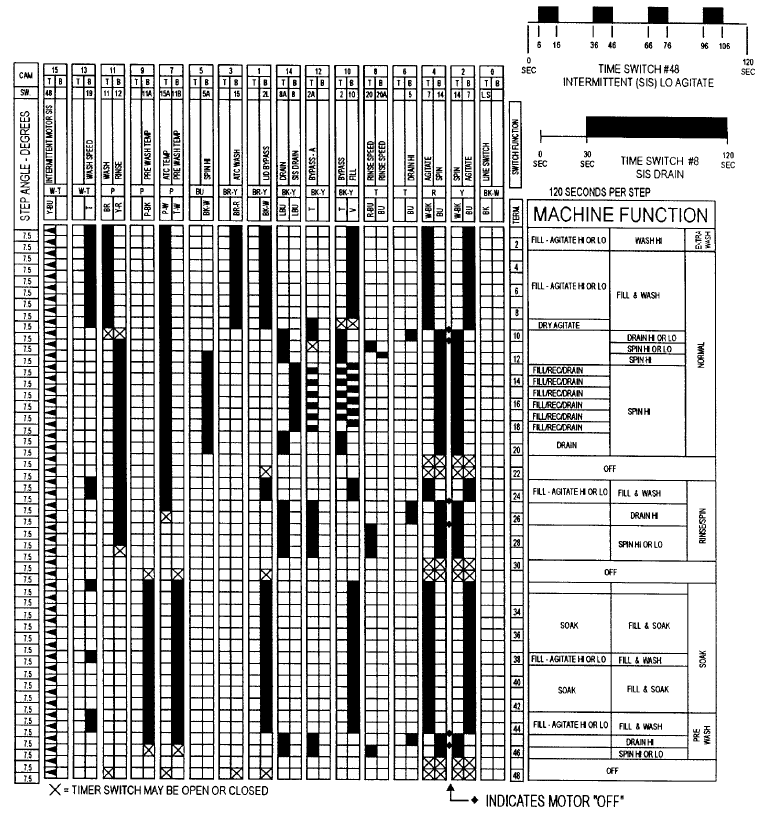

Similar threads
- Replies
- 78
- Views
- 3K
- Replies
- 11
- Views
- 1K
- Replies
- 132
- Views
- 10K
- Replies
- 6
- Views
- 2K


